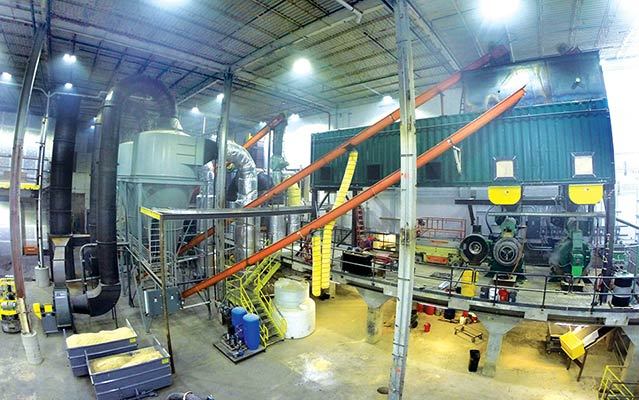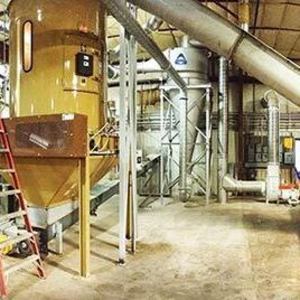Opportunity Still Knocks







PHOTO: SNOW TIMBER PELLET LLC
March 4, 2015
BY Carla Harper
New development in the small-scale pellet space is not a venture of the past. In the past year, at least four projects with annual production volumes of less than 40,000 metric tons of pellets were announced in very different regions, with very different feedstock situations, to say nothing of markets. Two of these relative newcomers—Snow Timber Pellets LLC and Queston Wood Pellets—are up and running with explicit aims to serve a largely local market.
By examining the stories of these two facilities, a common set of development characteristics shared by the two plants begins to emerge. Queston Wood Pellets and Snow Timber Pellets each were able to leverage existing capital, guaranteed feedstock supply, a familiarity with the requisite equipment, access to available markets and important transportation logistics to make their interest in pellet production become a reality.
Together with these critical factors for success, both felt compelled to provide a high quality, readily available pellet to a waiting domestic market. This commitment is good news for residential and light industrial pellet users in New England and the Midwest.
2 Small-Pellet Approaches
Snow Timber Pellets LLC is a pellet production effort of forest products manufacturers Snow Country Hardwoods and Snowbelt Hardwoods both based in Hurley, Wisconsin. Snowbelt Hardwoods has been operating since 1994, processing over 15 million board feet of hardwoods sourced predominantly from the forests of northern Wisconsin and Michigan’s Upper Peninsula. Snow Timber’s first load of pellets was shipped late last year and the plant is now operating two shifts a day, four days a week to produce around 240 tons of bagged pellets. Queston Wood Pellets, a spin-off of a Vermont-based family owned business in the New England industrial maintenance, engineering, and construction space, went into full production on Jan. 26 with a capacity of 35,000 tons annually.
A long time in development, the pellet production facility graduated from test batches and incremental production to daily volumes closer to their nameplate capacity Jan. 25.
“Today is the final shakedown,” says Steven Querrey, co-owner of the company with his brother, Dan Querrey, who serves as president. “We’ve been making pellets, but in one-off tons. We stop and tweak, and then start again. Tomorrow is full production.”
Influencing Factors
Industry headlines the past several years have been dominated by the development of pellet facilities with capacities in the 500,000 tons per year range. Buoyed by financial incentives and carbon policy, entrepreneurs and project developers had little trouble amassing capital to enter the export market. The first of these projects began to emerge in the mid-2000s and new projects continue to be announced on a nearly monthly basis.
Whether European demand continues its impressive momentum is of little consequence for Queston or Snow Timber. Both of these newcomers built their facilities to serve entirely different, and much closer-to-home markets.
“We can’t compete with the East Coast when it comes to exporting our pellets into European markets; trucking to a rail line is a huge cost and not feasible for us at the moment,” Brady Francois, of Snow Timber Pellet, tells Biomass Magazine.
Stable, Priced Right, Ample
It’s hard to underestimate the role of supply in making a pellet operation work. More than a few newcomers to the pellet game have shut down over the past five years or more due to supply issues. Manufacturers in the West have business models challenged by an inability to consistently get access to feedstock. Time and time again, pellet project developers build business plans that rely upon forest thinning contracts from federal lands only to become acutely aware of the difficulty of these stewardship contracts when put into practice.
In regions where more land is private and longer growing seasons dominate, the cost of raw material is at play.
For Queston in Vermont, it’s a different story. “We have a lot of support within the chip industry with many companies wanting us to succeed,” Dan says.
Phase two of Queston's plan involves a log yard where they bring in wood tapped from a 68-mile radius Vermont wood basket. Debarking and chipping will take place in the yard. The operation currently has a good relationship with a wood chip distributor.
For the Snow Timber team, access to raw materials is central to their business plan and a competitive advantage they are eager to leverage. “We consider the high price mills are paying for pulpwood a big indicator for the future of our product,” Francois says. “A lot of people here burn wood in outside boilers. The cost of pulpwood is ridiculous. Many folks with their own wood burning boilers are migrating towards pellets.”
For some producers, this rising price of pulpwood would present some very acute financial challenges. However, like other producers before them, Snow Timber Pellets is closely aligned with a parent facility already actively engaged in value-added forest products manufacturing.
Snowbelt Hardwoods, in business since 1994, is a hardwood dry kiln operation that is one of five operating companies that coexist on a 55-acre site near Hurley, Wisconsin. The tip of the spear for these companies is Snow Ridge Lumber, which receives inbound logs and converts them into dimensional lumber. Wood chips and other residual woody byproducts from Snow Ridge Lumber are consumed by the kilns at colocated Snowbelt Hardwoods, which kiln dries green lumber from Snow Ridge. Finally, Snow Country Hardwoods converts the dried lumber into solid hardwood flooring, and a wide range of finished moulding and millwork. The sawdust generated by Snow Country Hardwoods supplies the vast majority of Snow Timber’s raw material needs. The fifth company operating under this broad umbrella is Snow Run Trucking, which the other companies utilize to get their products to market.
Collectively this family of companies seemed the perfect seedbed from which to grow a pellet production facility. Not only does Snow Timber enjoy ready access to feedstocks and important distribution logistics, the company was able to leverage robust in-house engineering and equipment expertise to bring the various components of their pellet production online and keep it running. “We looked at several different options for several years,” Francois says. “We considered everything from producing our own electricity to producing colored mulch, to pellet making. Ultimately, a pellet plant made the most sense for us.”
Starting With An Idea
Without an already deployed family of forest product manufacturing facilities to leverage, the development team at Queston turned to intellectual property to gain traction with investors.
Before there was a Queston Wood Pellets, the same ownership group had formed the entity Clean Tech LLC, which developed a patent-pending technology for producing a pellet that when burned emits fewer greenhouse gases and far less acid than a traditional pellet.
“We’re putting our pellets on Tums,” Dan Querrey offers. “We are neutralizing the acids in our chips, which later become our pellets.”
This technology and the pending patents were then leveraged to generate investor confidence when the team went looking for capital.
“It really gave Queston some great value,” Dan says.
This momentum, paired with professional connections helped the Querreys amass $1.5 million in capital.
“We were able to be selective; even turned a couple down,” Steven Querrey says. “We’ve got an incredible group of investors.”
Still just weeks into their foray into making pellets full time, Queston will, for now, produce only conventional softwood pellets. Once the production team irons out all of the expected bugs and brings the facility into a more predictable and consistent output, the plan will be to manufacture these enhanced, low-acid pellets a couple of days each week.
“We’ve got several customers and clients who are waiting to run trials on our enhanced pellets” Dan says.
Dan Querrey notes that the marketplace value of the enhanced pellets is still being determined. “From a Btu perspective, when tested in a calorimeter these pellets are virtually identical to conventional wood pellets,” he says. “However, when we actually burn our enhanced pellets in an appliance, we find that the internal temperatures of the appliance are 6 to 11 percent hotter when compared to a control.”
Ultimately, Queston will look to leverage these enhancements in the marketplace via its own pellets as well as license the technology to other interested producers.
Finally, and while not a direct infusion of capital for the company, Queston sees Vermont’s tax credits for bulk pellet conversion as an industry boost. Vermont offers upwards of a $4,500 tax credit, depending upon the system type.
The team at Snow Timber Pellets, like their counterparts at Queston Wood Pellets are eager to achieve and maintain steady, nameplate capacity production.
“We had a large learning curve,” Francois says. “It took us about six months to get the process running once all equipment was ordered. We are pleased with the product and the plant is built for easy expansion.”
Owing to the vast majority of their inputs emanating from their forest products processing facilities, their pellet is composed of 95 percent hard maple and red oak kiln dried planer shavings and hog fuel. This formula yields the clean-burning pellet with a low-ash content and high-Btu content that discerning residential pellet consumers desire. “We use no written recipe or guidelines in making the pellets. We learned as we went along. We also believe in the use of third-party testers to ensure our quality,” Francois adds.
The Secret Sauce
Many serious pellet buyers live in rural areas. The manufacturer with the knowhow and wherewithal to reach those markets first, fastest, and the cheapest wins. Freight costs are a major factor. Pellets compete against the other energy sources that require no rolling transportation, like solar, wind and natural gas. Propane is the closest competitor to the pellet.
The Querrey family is all about local heating options. “We all have pellet stoves,” Steven says. “We’ve seen the market here monopolized by Big Box stores. There’s just not much local supply.”
Steven admits that to stay only in Vermont is not realistic, but has no plans to look for wood or customers outside of New England.
Snow Timber Pellets’ Francois says, “Logistics are key in this business. If we keep it local, that reduces transportation and enables us to balance quality, local availability, and keep the price competitive.” Snow Timber caters to a Wisconsin/Michigan base of customers buying pellets for its freestanding pellet stoves or pellet furnaces.
Queston produces both bulk and bagged pellets and aims for an even split amongst those two distribution approaches. They are proponents of the New England bulk delivery movement and are already working closely with bulk distributors. With an eye on continued growth in the bulk market, they are actively developing a softwood pellet with greater durability so that it can withstand the rigors of pneumatic delivery systems. Querrey says, “Even with No. 2 heating at relatively low prices right now, the pellet stove industry is still booming in Vermont. It just makes sense.”
Author: Carla Harper
carlamgarrison@gmail.com
Advertisement
Advertisement
Upcoming Events





